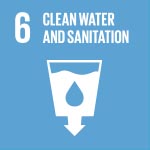In water aspects, the Group focus is aimed to promote not only the use of desalinated water in mining processes but also its efficient use at CAP Acero operations.
Water is becoming an increasingly scarce resource in Chile. In the north of our country, factors such as global warming, desert encroachment and the increase of the direct demand from agricultural and other economic sectors have caused this structural deficit to become a potential source of conflicts. A similar situation is experienced in the central zone as a result of excessive water allocations and overexploitation of aquifers.
In 2017, a Water Code Reform was approved in Chile with the purpose of securing human consumption as the main priority and allowing the State to have a wider scope of action in critical situations. While this new scenario marks a step forward in the construction of a more sustainable hydric system, its coming into effect does not mean the parties involved are released from their obligation to generate more efficient and accountable models.
Well aware as we are of the strategic value this resource represents, all CAP Group operations, particularly CAP Minería and CAP Acero, are equipped with programs and systems that seek to reduce water consumption, water losses and increase its reuse.
In 2017, the CAP Group companies ratified their commitment to pursue an efficient use of water by conducting action plans especially tailored to their respective operations needs and possibilities. Thus, CAP Minería developed initiatives such as:
At El Romeral mines the solids contained in thickeners’ discharges and flocculant consumption in the operation were controlled and water recovery from El Trigo reservoir was increased.
At Los Colorados mine roadway irrigation was replaced by bischofite, which returned 20% consumption savings against the base case.
At the pellets plant roadway watering was replaced by asphalt pavement (9.6 km). This meant 60% consumption savings with respect to the base case.
In order to respond to SD2129 from the Ministry of Public Works, in effect since 2017 which updates the obligations of the holders of underground water allocation rights, in the course of the year, CAP Minería also conducted a survey and analysis of its water rights and adjusted the water withdrawal control systems for those rights specified in the resolution. Next, CAP Minería signed a sworn statement per extraction point, pursuant to the periodic reportability obligations mandated by the authority.
In 2017, Cintac introduced some modifications intended to reduce water consumption at the rinse tanks. As for TASA, one of its main goals for 2018, in water aspects, is to create an environmental committee tasked, among others, to design a program to reduce water consumption at the operations.
Tupemesa, in turn, operates with wastewater treatment plants that allow water to be reused by recategorizing its quality. Once processed, wastewaters received from these operations are given category III, which means fit for green area watering.
| Minería | Acero | Cintac | Tasa | Tupemesa | |||||||
|---|---|---|---|---|---|---|---|---|---|---|---|
| 2015 | 2016 | 2017 | 2015 | 2016 | 2017 | 2015 | 2016 | 2017 | 2017 | 2017 | |
| Volume of water consumed (thousand m3) | 18,523 | 14,742 | 14,771 | 39,507 | 37,350 | 41,782 | 80 | 76 | 79 | 47 | 3.9 |
| % seawater | 73% | 61% | 47% | 0% | 0% | 0% | 0% | 0% | 0% | 0% | 0% |
| % water from surface sources | 14% | 21% | 23% | 100% | 100% | 100% | 0% | 0% | 0% | 0% | 0% |
| % water from ground sources | 13% | 18% | 21% | 0% | 0% | 0% | 100% | 100% | 100% | 100% | 38% 1 |
| % industrial water or supplied by third parties | 0% | 0% | 8% | 0% | 0% | 0% | 0% | 0% | 0% | 0% | 62% |
| % of water recycled or reused | 89% | 96% | 65% | 61% | 63% | 60% | 0% | 0% | 0% | 0% | 0% |
| 1 The remaining percentage comes from industrial water or third-party supplies. | |||||||||||

In 2014, CAP inaugurated its first seawater desalination plant at Punta Totoralillo, Caldera, Atacama region.
Nowadays, this facility has become an integral part of the company’s infrastructure area and it not only feeds the Magnetita plant and Cerro Negro Norte mine sites but also provides services to other neighboring firms, such as Caserones mine.
This facility has turned out to be an effective and sustainable water source for CAP operations as well as an important enabler of the new mining projects that may be pursued in the north of Chile, a critical sector from a water availability standpoint.
In 2017, the plant desalinated 6,9 million m3 of water, out of 17,395 million m3 of water withdrawn from the sea.
| Desalination plant | |||
|---|---|---|---|
| 2015 | 2016 | 2017 | |
| Volume of seawater extracted (thousand m3) | 15,000 | 17,712 | 17,395 |
| Volume of water desalinated (thousand m3) | 7,500 | 7,236 | 6,953 |
